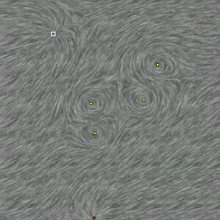Line integral convolution
The Line Integral Convolution (abbreviation: LIC, in German: line integral convolution ) is a method for the scientific visualization of vector fields (e.g. flow fields ). It provides a global method to represent all interesting areas of the vector field.
The method was initially developed for stationary 2D fields. To obtain a LIC representation of such a field is a two-dimensional white noise along the lines of the flow field having a core with a local carrier is folded (in the simplest case: averaged local). The pixel values along the field lines are thus strongly correlated, but orthogonal to them - due to the noise - almost uncorrelated. As a result, the field lines stand out optically from the background and become visible. The method of representation is reminiscent of the procedure and result of the visualization of magnetic field lines with the help of randomly distributed iron filings.
Extensions of the method to time-dependent 2D fields as well as to 3D fields have also been proposed.
literature
- Brian Cabral, Leith Casey Leedom: Imaging Vector Fields Using Line Integral Convolution . In: Proceedings of ACM SIGGRAPH '93, Aug 2-6, Anaheim, California, pp. 263-270, 1993. doi : 10.1145 / 166117.166151
- Detlev Stalling, Hans-Christian Hege: Fast and Resolution Independent Line Integral Convolution . In: Proceedings of ACM SIGGRAPH '95, Aug 6-11, Los Angeles, California, pp. 249-256, 1995. doi : 10.1145 / 218380.218448
- Henrik Battke, Detlev Stalling, Hans-Christian Hege: Fast Line Integral Convolution for Arbitrary Surfaces in 3D (PDF; 2.5 MB) . In: Hans-Christian Hege, Konrad Polthier (Ed.): Visualization and Mathematics: Experiments, Simulations, and Environments , Springer , Berlin, New York, pp. 181-195, 1997, ISBN 3-540-61269-6
